LisbonLisboaPortugal.com
The best independent guide to Lisbon
LisbonLisboaPortugal.com
The best independent guide to Lisbon
Lisbon in 1 day: a self-guided walking tour of central Lisbon
While Lisbon is a large and sprawling city, its most captivating historic sights are clustered within a compact centre that is best explored on foot. A walking tour offers a much richer experience than the expensive tuk-tuk rides or limited hop-on-hop-off buses, allowing you to discover the hidden alleys and authentic details that define the city.
However, navigating the steep hills and maze-like streets of districts like Alfama and Baixa can be challenging. Without a well-planned route, a day of sightseeing can quickly become exhausting, leading to backtracking and missed opportunities.
This guide details a walking tour designed to provide a logical route through the city, revealing some hidden gems along the way. The itinerary has been carefully structured to maximise sightseeing while minimising uphill climbs, allowing you to experience the best of central Lisbon in a single day, all at your own pace.
A self-guided 1-day walking tour of Lisbon
Our 1-day walking tour of Lisbon is the ideal introduction to the city and covers the Alfama, Baixa, and Bairro Alto districts. The tour begins at Rossio Plaza (marker 1) and finishes at Ribeira das Naus (marker 26). This walking tour is ideally taken on your first day in Lisbon.
Insight: We recommend spending three days in Lisbon. After your first day exploring the historic centre, dedicate your second day to the Belém district and, if time permits, the Alcântara area. On your third day, visit Parque das Nações in the morning, then explore the Príncipe Real and Estrela neighbourhoods in the afternoon.
The walking tour covers a total distance of 9.8 km (6.1 miles), but this could be easily divided into two days (by finishing at marker 14) if you prefer a slower pace of sightseeing. The tour involves walking up some of Lisbon's hills, but a significant amount of uphill walking is avoided with the use of the two free lifts on either side of point 6.
A map of the 1-day walking tour is shown below, and a full description is provided in the next section. (Note: Zoom in or out to see all of the points)
Legend: 1) Rossio 2) Elevador da Glória 3) A Ginjinha 4) Igreja de São Domingos 5) Praça da Figueira 6) Bifanas do Afonso 7) Castelo de São Jorge 8) Miradouro das Portas do Sol 9) Alfama district 10) Largo do Chafariz de Dentro 11) Sé de Lisboa 12) Igreja de Santo António 13) Casa dos Bicos 14) Praça do Comércio 15) Rua Augusta 16) Elevador de Santa Justa 17) Rua Garrett 18) Igreja do Carmo 19) Igreja de São Roque 20) São Pedro de Alcantara viewpoint 21) Príncipe Real district (optional) 22) Bairro Alto district 23) Praça de Luís de Camões 24) Pink Street 25) Timeout food market 26) Ribeira das Naus
An expanded version of this map can be seen here. If you share it, please credit us, as it takes significant time to create these maps and guides.
If you are visiting Lisbon as a cruise ship passenger, you could join the tour at Largo do Chafariz de Dentro (10) and follow it up to the Rua Augusta (15) to continue the tour at Rossio Plaza (1).
During the heat of summer, or if you prefer a more relaxed pace of sightseeing, you could easily divide this tour into two parts. Day one would cover points 1 to 14, and the second day would follow the route from points 15 to 26.
Guide to the 1-day walking tour
This section provides details of the walking tour and included images of the main sights along the route.
The tour begins at Rossio (1), the main plaza of Lisbon. This magnificent plaza contains two baroque fountains and a monument dedicated to King Pedro IV, but its most notable feature is the ‘calçada’ cobblestone pavements that create wave-like patterns. Surrounding Rossio Plaza are grand 18th-century buildings, which include the Teatro Nacional Dona Maria II at the northern end, and this is the direction to continue the tour.
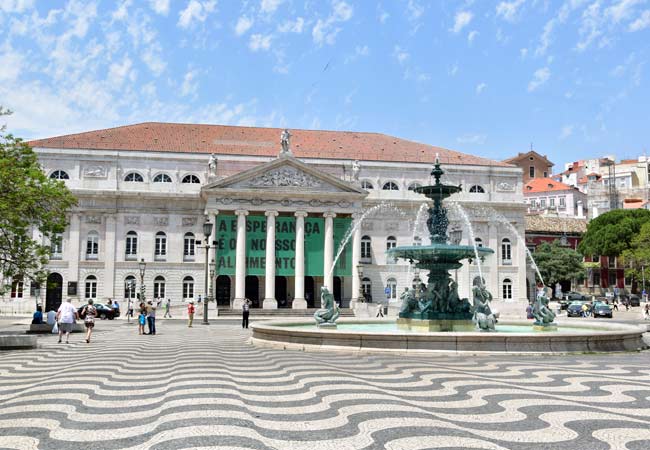
The majestic Teatro Nacional Dona Maria II
Heading north leads past the decorative Rossio train station. The station was built in the late 19th century and is a stunning example of Neo-Manueline architecture, featuring intricate stonework, arched windows, and two grand horseshoe-shaped entrances.
The trains that depart from Rossio station head to Sintra, and you will want to take a day trip to Sintra during your holiday. (See our guide to Sintra)
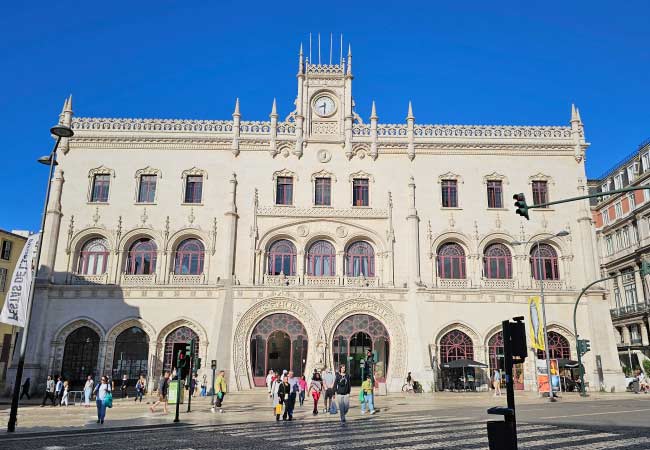
The historic Rossio Railway Station with its Neo-Manueline façade
Beyond Rossio station is the Praça dos Restauradores, which commemorates the independence of Portugal from Spanish joint rule in 1668. The striking feature at the centre is the huge obelisk, the Monumento dos Restauradores. Other notable sights include the Teatro Eden (now a hotel) with its Art Deco façade and the pink-coloured Palácio Foz.
Leading from the Praça dos Restauradores is the Avenida da Liberdade, a wide, tree-lined boulevard that is home to many of Lisbon’s high fashion stalls and boutiques. The Avenida da Liberdade is a pleasant area to explore later during your holiday in Lisbon.
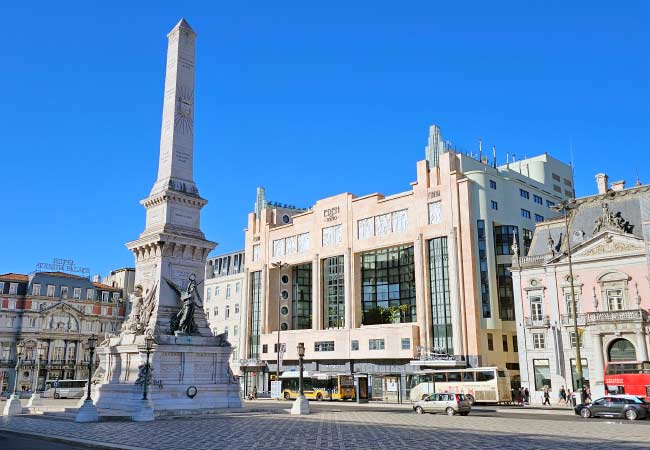
The Teatro Eden, Palácio Foz and Monumento dos Restauradores
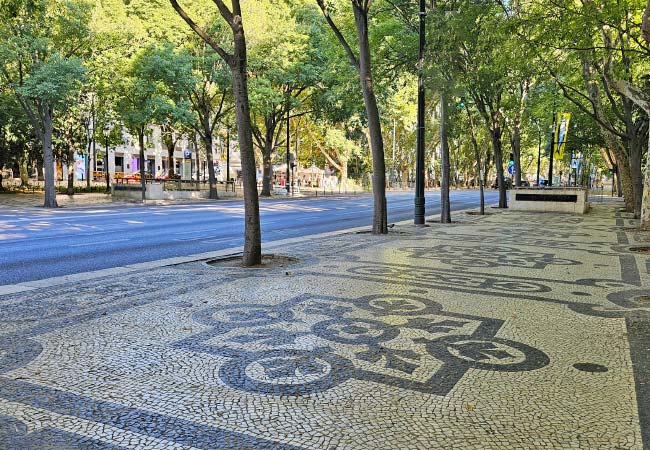
The magnificent Avenida da Liberdade with its elegant boutiques
The Elevador da Glória (2) lies to the northern side of Praça dos Restauradores. This charming yellow funicular, dating from 1885, transports passengers up the steep hill to the Bairro Alto neighbourhood. Originally water-powered using counterweights, it was converted to electricity in 1915.
The upper sections and the Miradouro de São Pedro de Alcântara viewpoint (20) will be visited later in this tour.
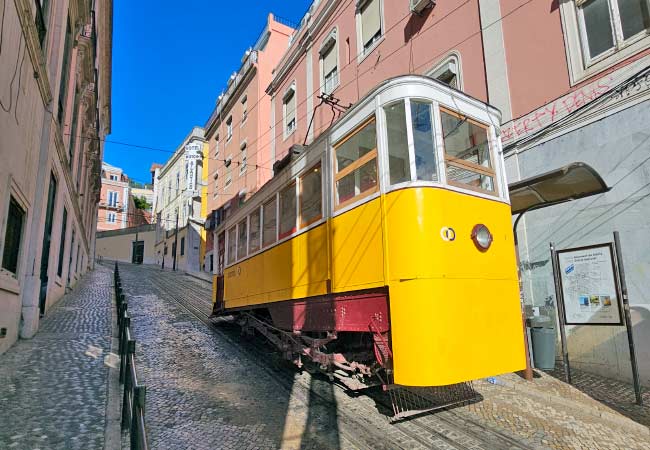
The historic Gloria Funicular tram
The tour now wanders down Rua das Portas de Santo Antão, which is the theatre district of Lisbon. At the end of the pedestrianised street is the ‘A Ginjinha’ bar, which serves the traditional Portuguese cherry liqueur Ginjinha.
There are now many gimmicky stalls that serve Ginjinha in chocolate cups, but this was the original bar that created the drink.
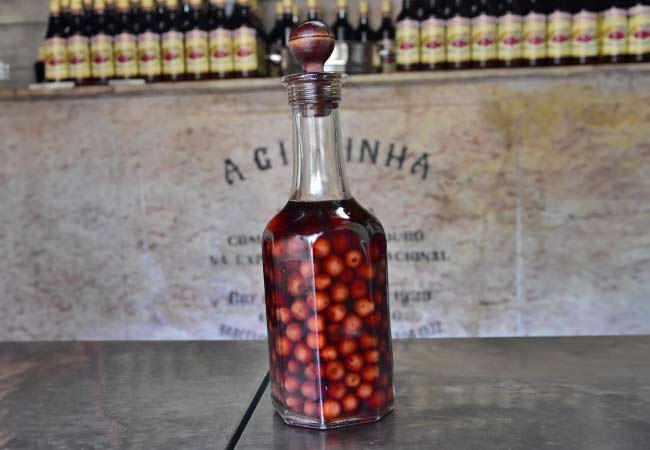
The bottle of Ginjinha
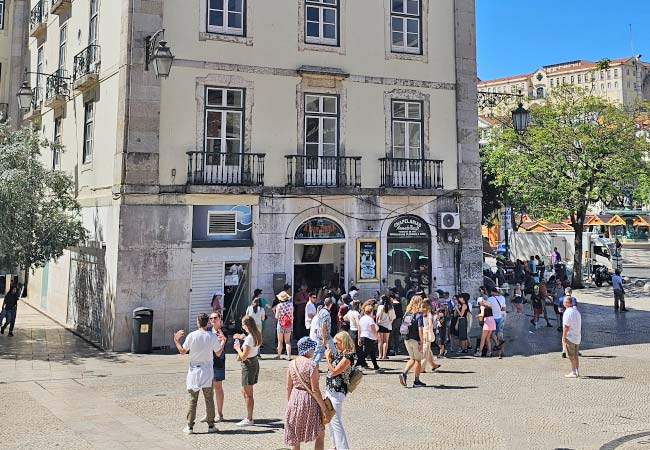
Summertime sightseeing deserves a mid-morning Ginjinha!
Across the street from ‘A Ginjinha’ is the São Domingos Church (4), a 13th-century church that bears the scars of a devastating fire in 1959. Its unique interior blends the fire-ravaged pillars and walls with the restored roof. It is also reputed that the air within the church still smells of smoke from the fire.
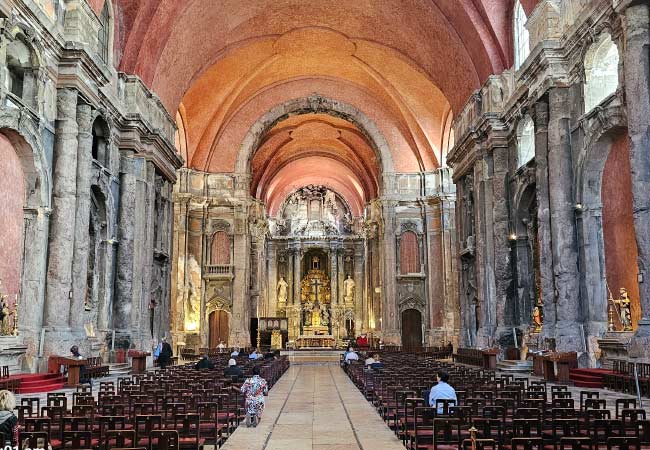
The original fire-damaged columns and restored roof of Igreja de São Domingos
The tour now crosses the Praça da Figueira (5), another of the Baixa district’s grand plazas. This plaza often hosts pop-up markets and stalls, while at the centre is an impressive bronze equestrian statue of King John I.
Praça da Figueira is also a bit of a transport hub for tourists. The E15 tram to Belém departs from here. There is an entrance to the Rossio metro station, and the Yellow Tour Hop-on Hop-off buses start from here. It is also a congregating point for Tuk-Tuk tours.
On the plaza is the Confeitaria Nacional, one of Lisbon’s traditional coffee shops, while the Casa das Bifanas is a great stop for inexpensive Portuguese food.
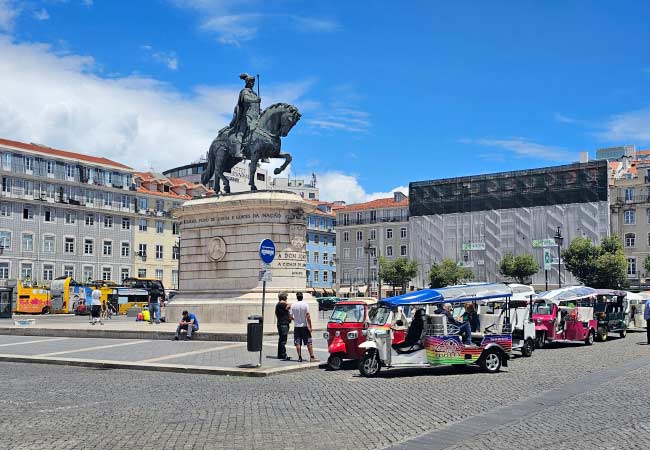
Tuk-tuks, tour buses, metro and taxis, everything you need to travel around Lisbon
Exit the Praça da Figueira onto Rua da Prata and follow it until you reach the Igreja de São Nicolau, where you turn left. The Igreja de São Nicolau is another impressive Baroque church - one of many in Lisbon - but it is worth a visit to see the wonderfully painted ceilings.
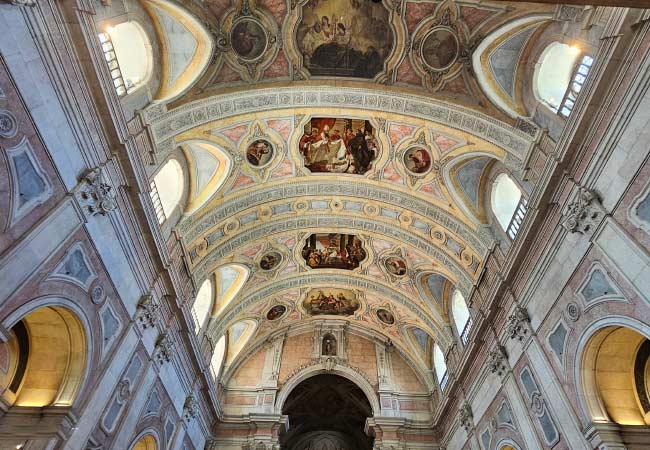
The Baroque Igreja de São Nicolau with its artistic ceiling paintings
This next section of the tour climbs the hill from Baixa into the Alfama district, but fortunately, there are two free lifts (known as the Elevador Castelo) to reduce the amount of uphill walking. The first part of the ‘Elevador Castelo’ is in a grand 18th century building, while the second lift is within a Pingo Doce supermarket.
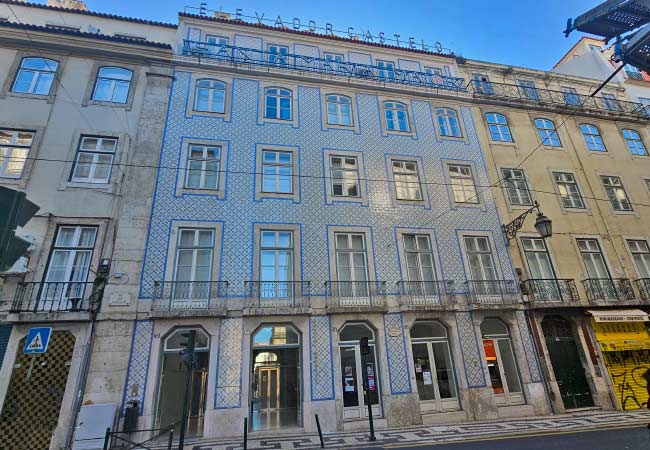
The entrance to the first Elevador Castelo, close to the Igreja de São Nicolau
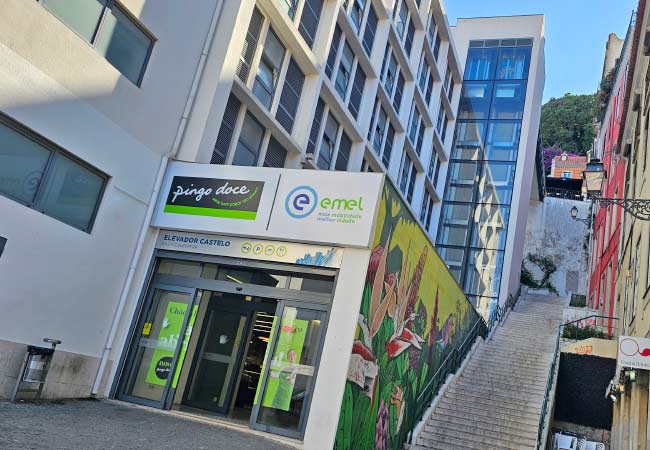
The second part of the Elevador Castelo, which is within the Pingo Doce supermarket, or you could take the stairs if you want…
Between the two lifts is the Adelino Amaro da Costa plaza and the ‘As Bifanas do Afonso’ (6) a small shop selling reputably the best Bifanas in Lisbon.
A ‘Bifana’ is the Portuguese version of fast food, consisting of a tender marinated pork cutlet served in a ‘Papo Seco’ crusty bread roll with mustard or spicy sauce. This is the perfect snack during a long day of sightseeing.

The ‘As Bifanas do Afonso’ usually when it is open there is a long queue down the street
The route now meanders along the upper streets of the Alfama district towards the castle. Along the way you will pass the Chapitô arts college, beautiful tile paints of Saint Anthony miracles and Arco do Castelo.
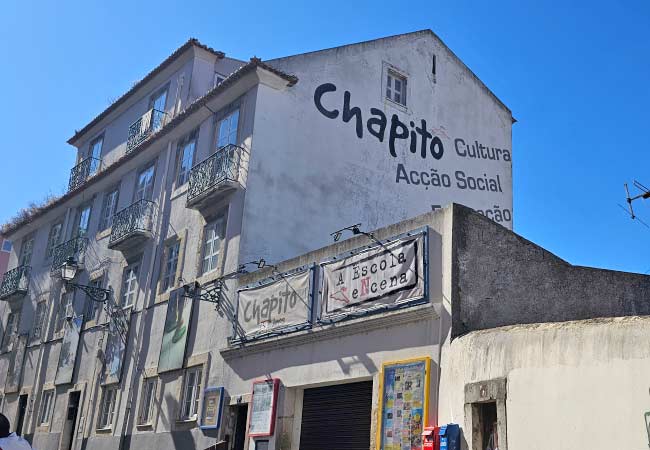
The creative atmosphere of the Chapitô Arts School
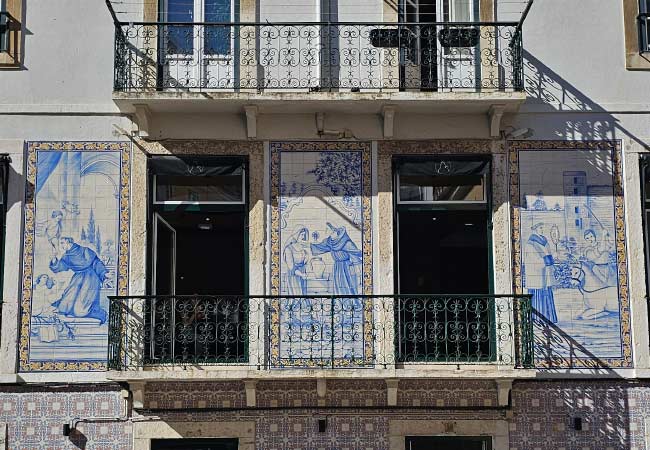
The miracles of Saint Anthony
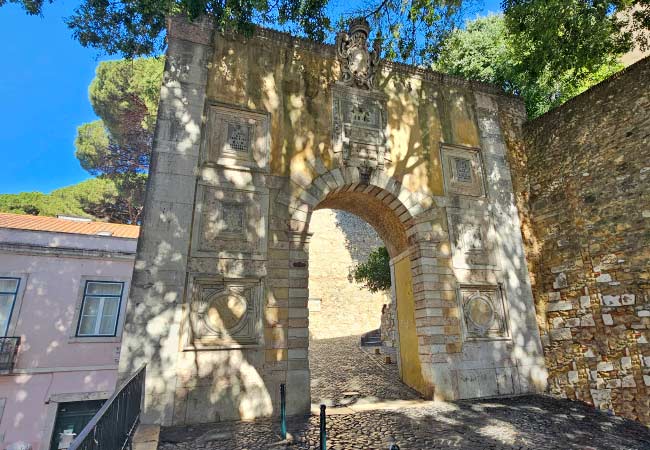
The Arco do Castelo
On reaching the Castelo de São Jorge (7), you may decide to enter, but it is recommended to save it for another day. The castle takes around 90 minutes to fully explore, and during peak season, there can be very long queues to buy tickets. For a full guide to Lisbon castle please click here.
The castle dates back to the Moorish era (11th century), but was significantly enhanced (almost completely rebuilt) during the Salazar dictatorship to promote the country's historic patriotism.

Panoramic view of the Tagus estuary from the castle walls
After all the uphill walking to the castle, there is now a downhill section that passes through a charming part of Alfama and leads to Portas do Sol (8). This plaza is the largest open space in Alfama and provides wonderful views over the tiled roofs and out to the cruise terminal and the Tejo estuary.
Behind the Igreja de Santa Luzia is a small garden and viewpoint (the Miradouro de Santa Luzia), which is a popular location for photos.
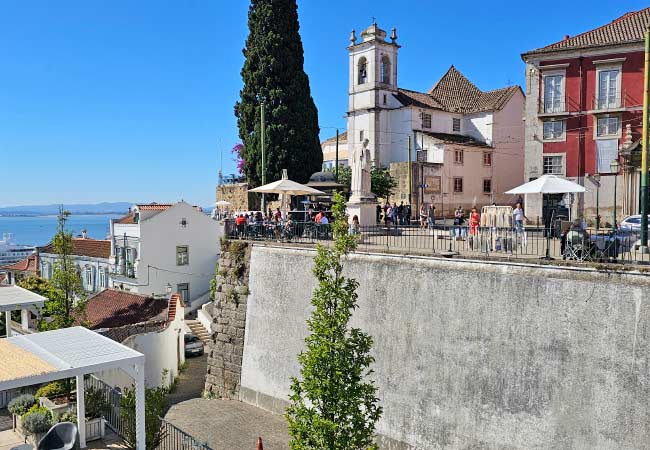
The historic Portas do Sol square

The view from the Miradouro das Portas do Sol

The picturesque Miradouro de Santa Luzia, but expect a long queue to get a photo from this location
The tour now descends the narrow streets and steps through the heart of Alfama (9) to the Paroquial de São Miguel church. This is one of the prettiest areas of Lisbon, with closely packed houses and tiny cobbled streets that have barely changed since the medieval period.
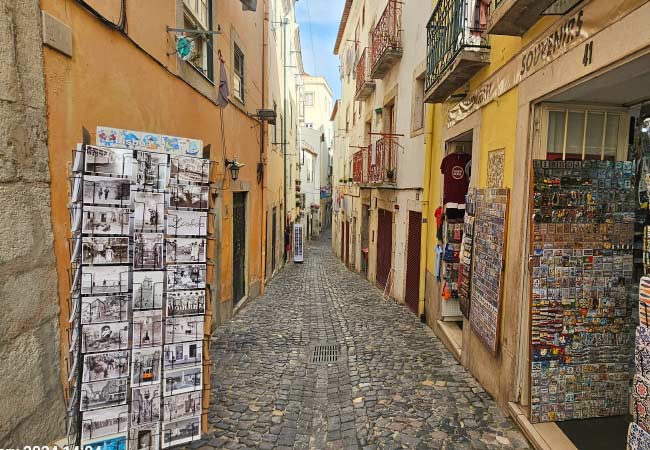
The tiny Rua de São Pedro, which can get very packed if a cruise ship has recently moored at the cruise terminal
If you are enjoying this Alfama section, you could extend it to include the Largo do Chafariz de Dentro (10) and the Rua dos Remédios. The Rua dos Remédios is one of the main shopping streets of Alfama, but unfortunately it heads eastwards and away from the next section of the tour.
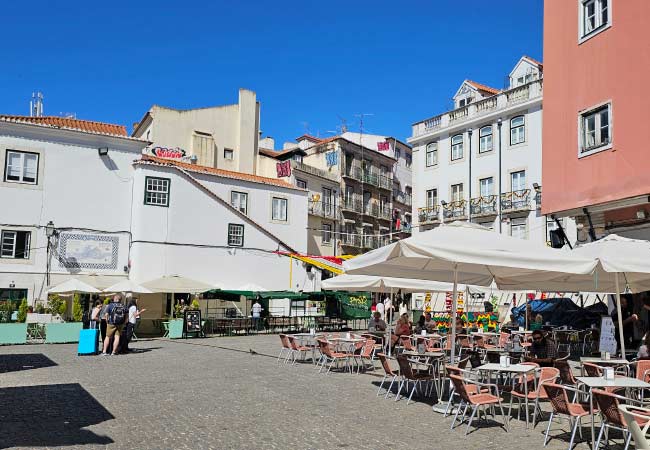
The Largo do Chafariz de Dentro
After leaving the maze of Alfama head westwards along the Rua de São João da Praça towards the Sé (11). The cathedral was constructed as a statement of power over Moorish population after Lisbon was captured by the crusaders in 1147. The walls are massive and the interior is austere, but it makes for a great photo opportunity when the number 28 tram trundles past it.
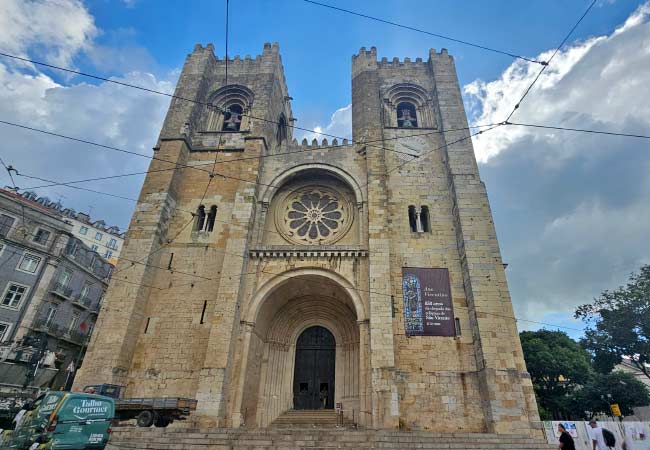
Slightly down the hill from the cathedral is the Igreja de Santo António (12), which was built on the birthplace of Saint Anthony. This 18th-century Baroque church boasts an ornate interior with gilded woodwork and azulejo tiles, while the chapel in the basement marks the location of his birth.
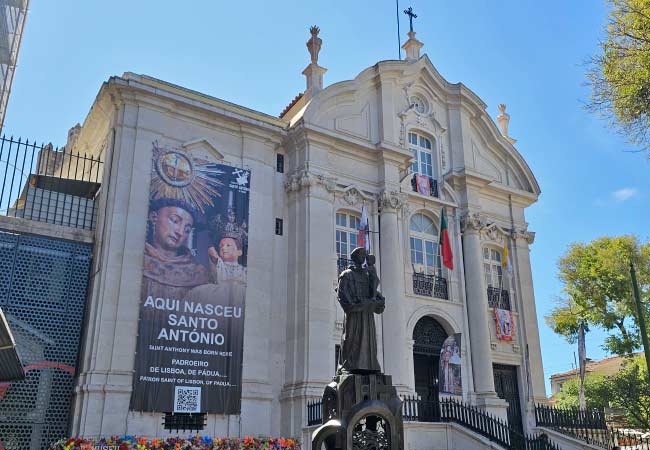
The final sight of the Alfama district is the Casa dos Bicos (13), a unique example of Portuguese Manueline and Renaissance architecture that dates from 1523. Its façade features over 1,000 diamond-shaped stone points, earning it the nickname "House of Spikes."
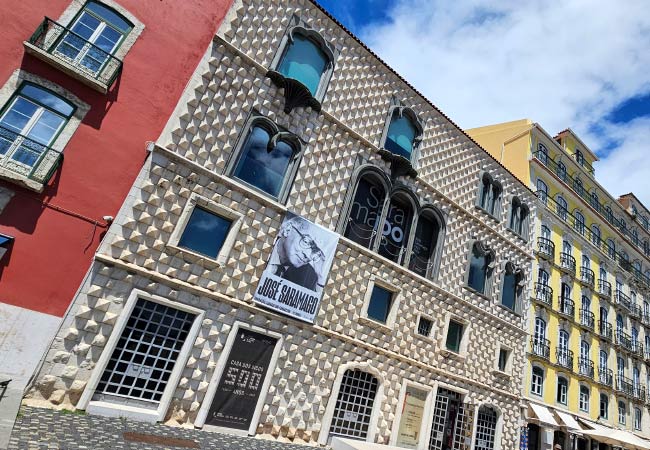
The unique diamond façade of Casa dos Bicos"
The tour now enters the Praça do Comércio (14), Lisbon's mightiest plaza. At the centre stands a statue of King José I, and to the northern side is the impressive Arco da Rua Augusta.
This plaza was originally the location of the Ribeira Palace (the main palace of Lisbon), but it was completely destroyed by the 1755 earthquake. During the 19th century, the Praça do Comércio became a centre for trade and the city's commercial hub (hence the name).
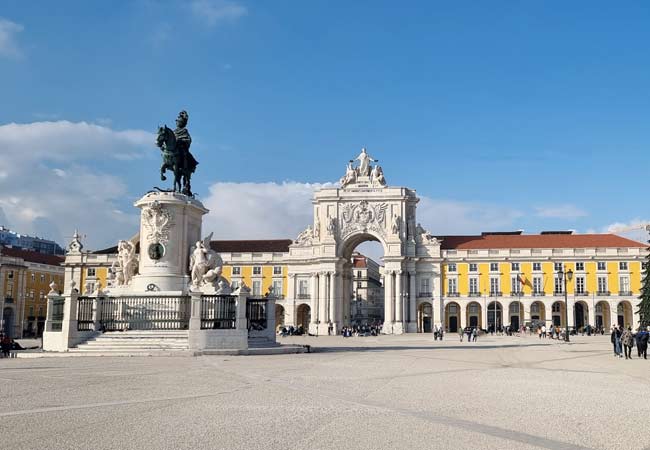
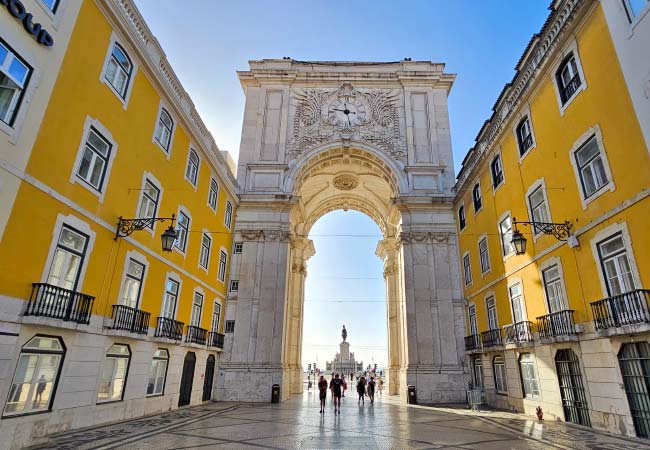
The Arco da Rua Augusta
The Arco da Rua Augusta leads to the Rua Augusta (15) Lisbon's main pedestrian thoroughfare. The street is lined with shops, cafes, and street performers, and is a great place to stop for a coffee or snack. There are many cafes here include the traditional Casa Brasileira and the delicious Pastéis de Nata from Manteigaria. Fábrica da Nata has a peaceful upstairs seating area and is a great location to view the whole street.
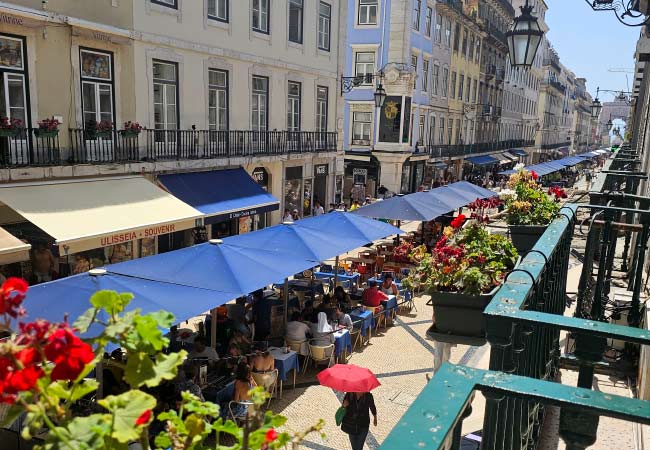
The Rua Augusta as seen from the Fábrica da Nata
While walking along the Rua Augusta you will pass the Elevador de Santa Justa (16), a 19th-century iron lift designed by Raul Mesnier de Ponsard, a student of Gustave Eiffel. It connects the lower Baixa district with the higher Carmo Square, offering panoramic views of Lisbon from its viewing platform. The only issue is that it is always very popular, and there can be a wait time of up to 45 minutes to ride it.
Insight: At this point, you may feel it's worth concluding the tour, as the following sections require uphill walking and you're approximately halfway through the route. If you choose to finish, Rossio Square (1) is just at the end of Rua Augusta.
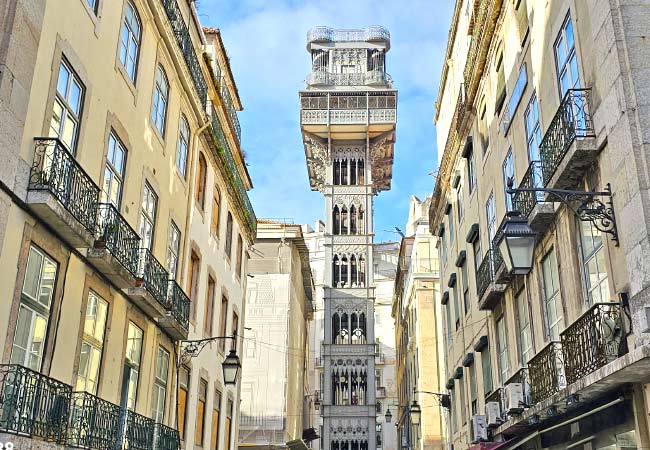
The next section has a gentle incline along the bustling shopping streets of Rua do Carmo and Rua Garrett (17) as it enters the Chiado neighbourhood. This area has historically been the shopping district of Lisbon and today offers a mix of multinational chains and independent shops.
Along Rua Garrett is Livraria Bertrand, the world's oldest bookstore, established here in 1732. Further along the street is Café A Brasileira, the first café to sell coffee made from Brazilian beans, and a favourite haunt of intellectuals and artists.
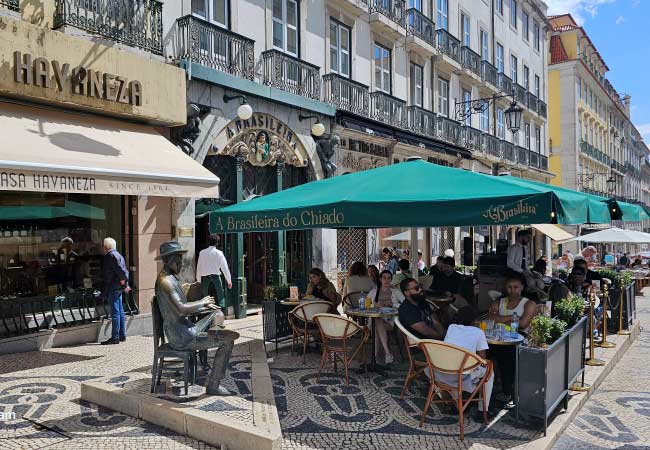
The historic Café A Brasileira with the statue of poet Fernando Pessoa
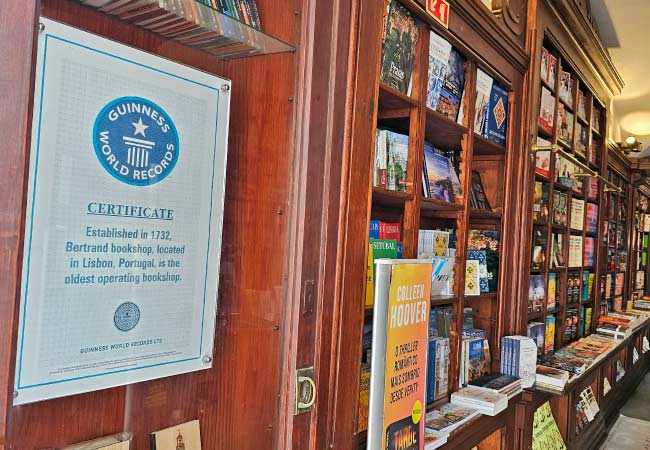
The Livraria Bertrand bookshop displays its world record certificate near its entrance.
From Rua Garrett, turn right and follow Travessa do Carmo up to the picturesque Largo do Carmo.
This plaza was originally the courtyard of the Igreja do Carmo church and featured a public fountain (the Chafariz do Carmo) that provided fresh drinking water. The Largo do Carmo is shaded by purple-flowering Jacaranda trees (in bloom from April to early June), and it is a peaceful place to stop for a drink.
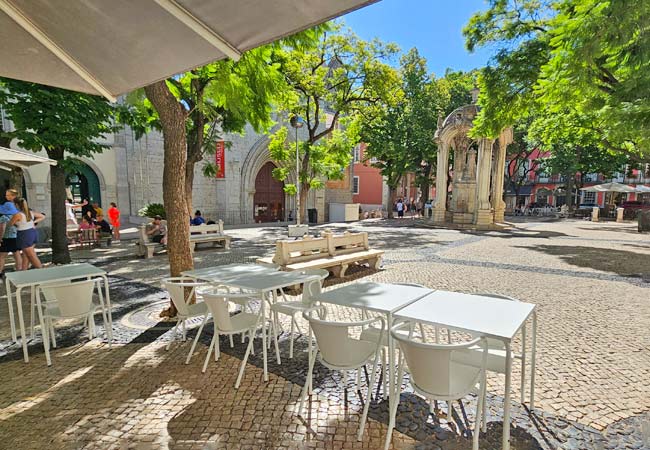
The tranquil Largo do Carmo under blooming Jacaranda trees
Standing on the Largo do Carmo is the Igreja do Carmo (18), which was Lisbon's largest medieval church until it was destroyed by the 1755 earthquake. The church was never restored and was left as a haunting reminder of the earthquake's devastation.
Inside the ruins of the church is the Museu Arqueológico do Carmo.
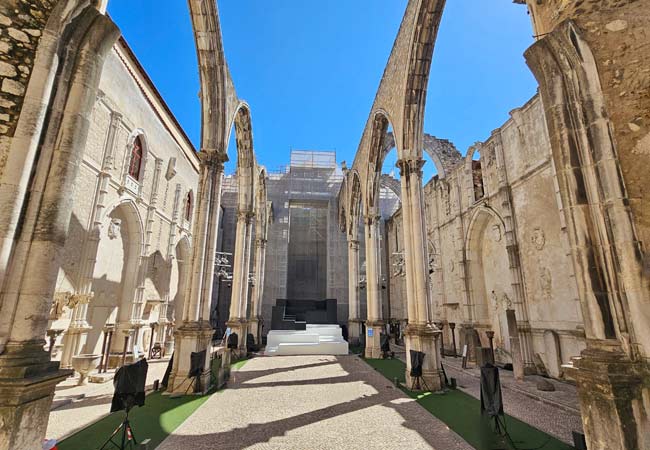
The impressive ruins of Igreja do Carmo
Before leaving the Largo do Carmo, admire the view from the top of the Elevador de Santa Justa. An alley to the right of Igreja do Carmo leads to the upper level of the lift and its viewpoint.
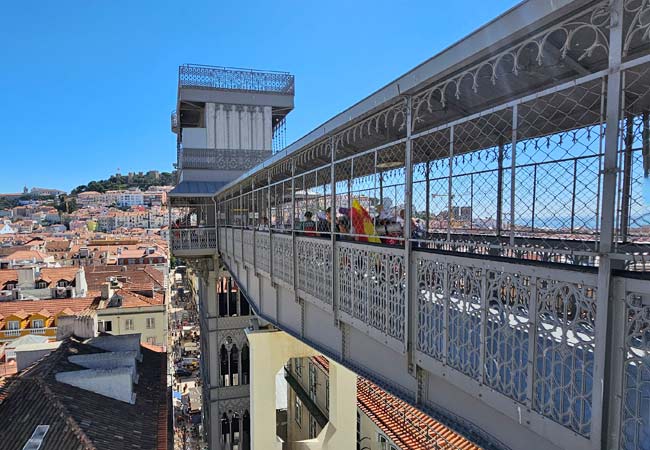
Spectacular view over the Baixa district from the Santa Justa Elevator viewing platform
The tour now heads to Igreja de São Roque. Along the way, you'll pass Calçada do Duque, a steep alleyway descending to Baixa that offers some of the most picturesque views and photo opportunities of the city.
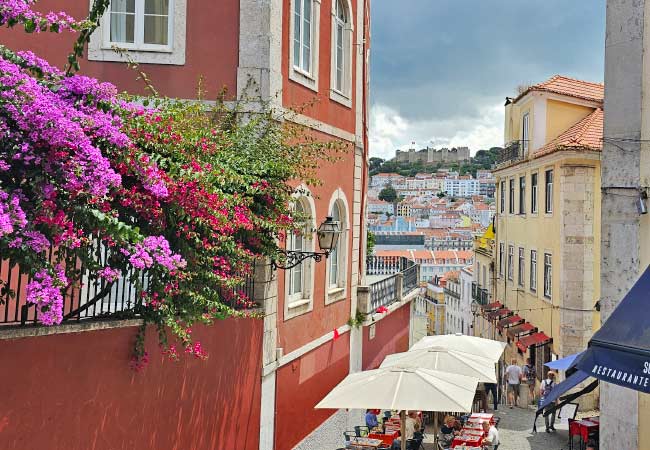
The picturesque Calçada do Duque with its scenic views"
The Igreja de São Roque (19) was the first Jesuit church built in Portugal, and one of the order's earliest churches. The modest exterior of the church does not hint at the extravagant interior, which features eight ornate chapels and a stunning painted ceiling.
The most elaborate of these is Capela de São João Baptista, reputedly the most expensive chapel ever built. Commissioned by King João V in 1742, it was constructed twice: first in Rome for the Pope's blessing, then reassembled in Lisbon after being dismantled and transported from Rome.

The opulent interior of Igreja de São Roque with its gilded chapels
The next sight is Miradouro de São Pedro de Alcântara (20), which sits at the top of Ascensor da Glória (2). This is one of Lisbon's finest viewpoints, and from its peaceful gardens, you can enjoy panoramic views over the Baixa district and down to the Tejo estuary.
Warning: Exercise caution when walking from Igreja de São Roque to Miradouro de São Pedro de Alcântara. The narrow pavement along this route only accommodates one pedestrian at a time and runs alongside a busy road. Accidents are common during peak times.
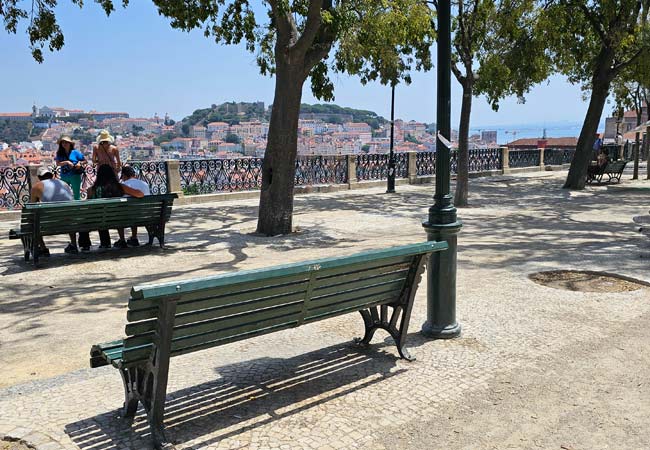
The Miradouro de São Pedro de Alcântara
Depending on your energy levels, you may want to explore Príncipe Real district (21) now or save it for later in your holiday.
Príncipe Real is one of Lisbon's most affluent neighbourhoods, filled with grand 19th-century mansions and colourful townhouses. At its center is the charming Jardim do Príncipe Real, while the main street (Rua Dom Pedro V) features designer stores and high-end restaurants. These include Embaixada, a unique shopping gallery housed in a restored 19th-century Arabian style palace.
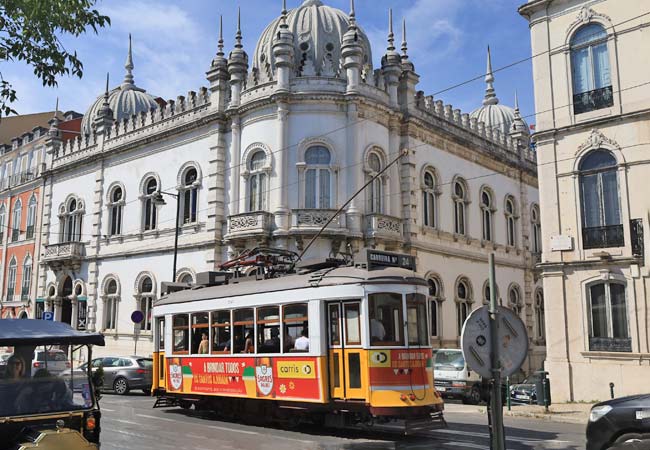
Embaixada and the number 24 tram
The tour now heads south through Bairro Alto (22), the nightlife district of Lisbon. The area may seem a little shabby by day, but at night it comes alive with hundreds of small bars and people socialising on the streets. (Guide to Lisbon's nightlife).
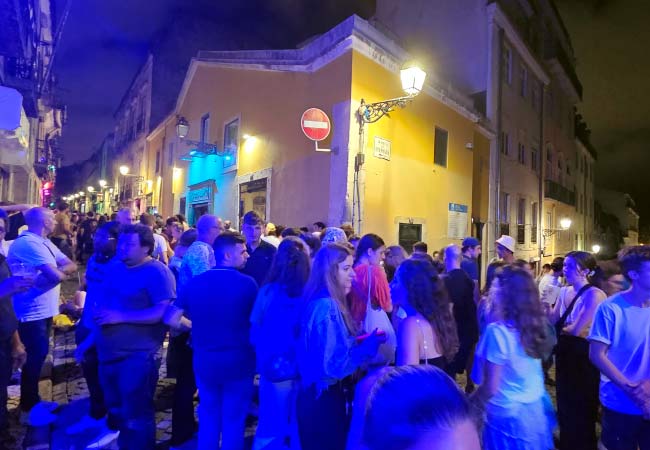
Nightlife in the alleyways of Bairro Alto
Heading south along the narrow streets of Bairro Alto, you'll emerge onto Praça de Luís de Camões (23).
This bustling square is dedicated to Portugal's national poet, Luís de Camões, whose large statue stands at its center.
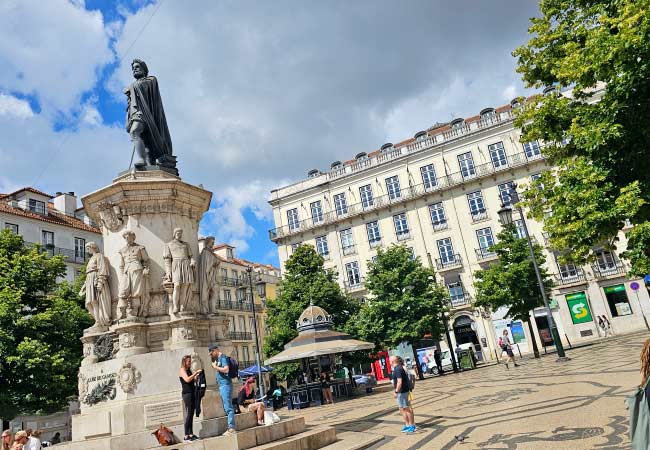
The tour now descends along Rua das Flores to the Cais do Sodré district. At the heart of Cais do Sodré is Pink Street (24), a former red-light district transformed into a trendy nightlife area.
A unique bar to peek into is Pensão Amor, a former 1970s brothel which has retained much of its risqué styling and décor.
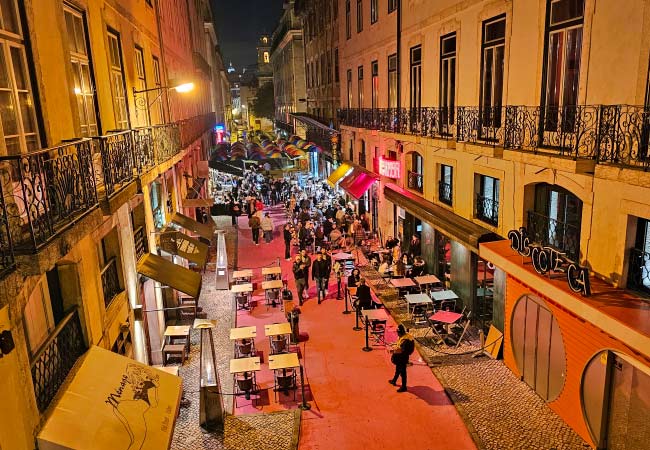
View of the distinctive Pink Street from Rua das Flores
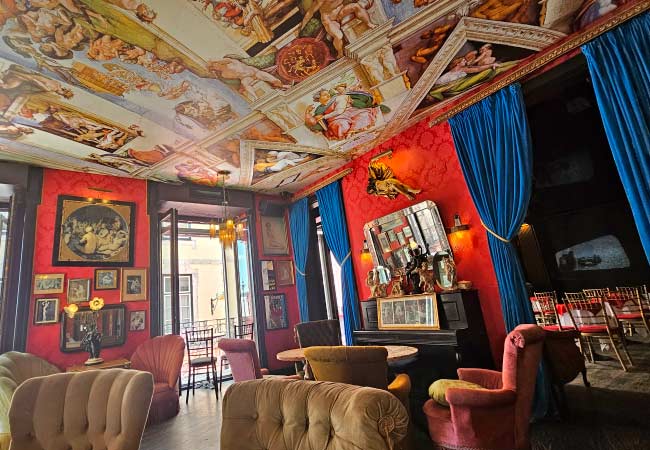
The stylish Pensão Amor bar with its historic décor
By now you must be getting hungry, and Time Out Market (25) is a great place to sample some of Portugal's unique cuisines. This gourmet food hall features over 40 carefully curated restaurants. Though now quite touristy, it's an excellent spot for a meal on your first day.
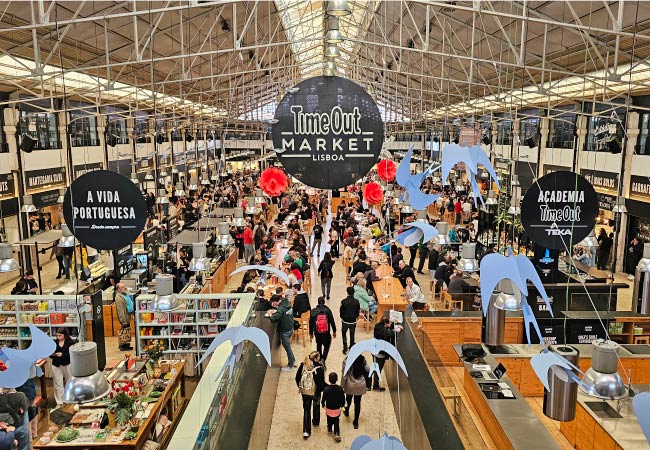
The tour concludes on Ribeira das Naus (26), the waterfront promenade between Cais do Sodré and Praça do Comércio. This area, once home to Lisbon's shipyards, now offers a scenic walkway with many places to stop for a drink. It's a popular location to watch the sunset or simply admire the wonderful views over the Tejo Estuary and Ponte 25 de Abril suspension bridge.
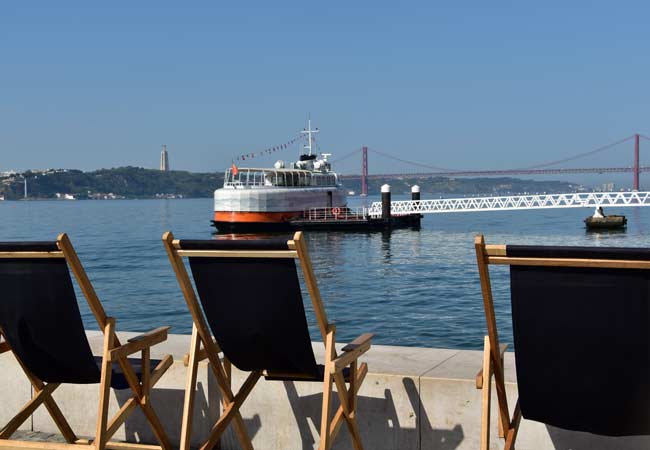
The view from Quiosque Ribeira das Naus
The tour ends at Praça do Comércio, from which you can either walk up Rua Augusta to Rossio plaza and the starting point, or catch the metro from Terreiro do Paço station.
Discover more of Lisbon with our most popular guides
If you've found our content valuable, we'd welcome your support.
The digital publishing landscape has evolved significantly. As a small independent publisher, we face growing challenges. Search engines increasingly favour paid content over organic results, while AI-generated content often reproduces original work without attribution.
To support our work, please consider bookmarking this page (press Ctrl + D) for quick access. If you find an article helpful, we'd be grateful if you'd share it with friends on social media.
For specific questions, please see our Reddit community at r/LisbonPortugalTravel.
Should you notice any outdated or incorrect information, please contact us at [email protected]
Thank you for helping us continue to provide valuable content in an increasingly challenging digital environment.
A complete list of all of our Lisbon articles
If you've found our content valuable, we'd welcome your support.
The digital publishing landscape has evolved significantly. As a small independent publisher, we face growing challenges. Search engines increasingly favour paid content over organic results, while AI-generated content often reproduces original work without attribution.
To support our work, please consider bookmarking this page (press Ctrl + D) for quick access. If you find an article helpful, we'd be grateful if you'd share it with friends on social media.
For specific questions, please see our Reddit community at r/LisbonPortugalTravel.
Should you notice any outdated or incorrect information, please contact us at [email protected]
Thank you for helping us continue to provide valuable content in an increasingly challenging digital environment.



































